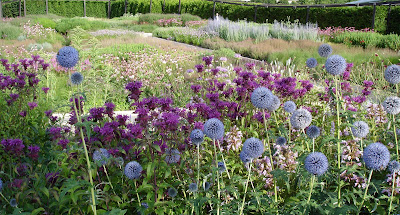Garden Tours are from 10 am to 1:30 pm and last about 20 minutes. In addition to the plants mentioned above, look for Allium 'Summer Beauty,' Echinacea 'Orange Madowbrite,' and Stachys officinalis 'Hummelo.'
Monday, July 5, 2010
Finding Blooms on the Garden Tours
Today as you stroll through the garden, look for a vibrant medley of blue and violet perennials located in the Transition Area of the Dark Plate, overlooking the Seam. Here is a good example of the way in which Piet Oudolf used plant shapes to add interest to the garden.
 Three kinds of globe-shaped flowers are interplanted for a natural look : bright blue Echinops bannaticus 'Blue Glow' (Globe Thistle); red violet Monarda didyma 'Scorpian, (Bee Balm); and the smaller, burgandy-clored Knautia macedonica (Knautia). In contrast, vertical spires of flower clusters define the space and draw the eye upward: lavender Veronica longifolia 'Evelyne' (Speedwell) at under 2 feet and the taller Veronicastrum virginiatum 'Temptation' (Culver's Root) that can grow to nearly five feet.
Three kinds of globe-shaped flowers are interplanted for a natural look : bright blue Echinops bannaticus 'Blue Glow' (Globe Thistle); red violet Monarda didyma 'Scorpian, (Bee Balm); and the smaller, burgandy-clored Knautia macedonica (Knautia). In contrast, vertical spires of flower clusters define the space and draw the eye upward: lavender Veronica longifolia 'Evelyne' (Speedwell) at under 2 feet and the taller Veronicastrum virginiatum 'Temptation' (Culver's Root) that can grow to nearly five feet.
 In bloom at the corner of the path, just south of this spot, is Astilbe chinensis 'Maggie Daley' (Astilbe), named for the first lady of Chicago. This violet lavender Astilbe is more compact than other varieties in the garden, standing about two feet tall with spires of branched pannicles that are densely covered with flowers. Its foliage is a deep green that is tinged with bronze. Maggie Daley will bloom late into summer, contrasting with the lavender spires of the Giant Hyssop across the path. This planting was an experiment last year - the garden staff tried to find another plant that could tolerate this sunny location.
In bloom at the corner of the path, just south of this spot, is Astilbe chinensis 'Maggie Daley' (Astilbe), named for the first lady of Chicago. This violet lavender Astilbe is more compact than other varieties in the garden, standing about two feet tall with spires of branched pannicles that are densely covered with flowers. Its foliage is a deep green that is tinged with bronze. Maggie Daley will bloom late into summer, contrasting with the lavender spires of the Giant Hyssop across the path. This planting was an experiment last year - the garden staff tried to find another plant that could tolerate this sunny location.
 Down the path and to the east of Maggie Daley is a 7-foot tall plant with huge, lettuce-green leaves - Inula magnifica 'Sonnenstrahl' (Fleabane). This perennial is magnificent if only for its foliage. Atop its sturdy stems are bright yellow daisy-like flowers with drooping petals, giving the appearance that each is wearing a grass skirt. Look beyond this planting to see similar yellow flowers of Silphium laciniatum (Compass Plant).
Down the path and to the east of Maggie Daley is a 7-foot tall plant with huge, lettuce-green leaves - Inula magnifica 'Sonnenstrahl' (Fleabane). This perennial is magnificent if only for its foliage. Atop its sturdy stems are bright yellow daisy-like flowers with drooping petals, giving the appearance that each is wearing a grass skirt. Look beyond this planting to see similar yellow flowers of Silphium laciniatum (Compass Plant).
Garden Tours are from 10 am to 1:30 pm and last about 20 minutes. In addition to the plants mentioned above, look for Allium 'Summer Beauty,' Echinacea 'Orange Madowbrite,' and Stachys officinalis 'Hummelo.'
Garden Tours are from 10 am to 1:30 pm and last about 20 minutes. In addition to the plants mentioned above, look for Allium 'Summer Beauty,' Echinacea 'Orange Madowbrite,' and Stachys officinalis 'Hummelo.'
Subscribe to:
Post Comments (Atom)


No comments:
Post a Comment